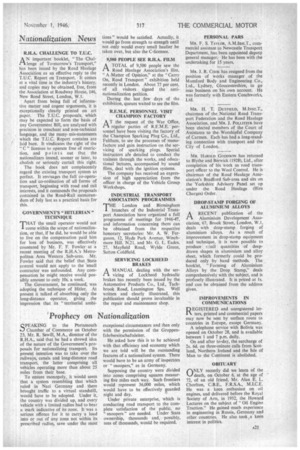'Prophecy on Nationalization
Page 23

If you've noticed an error in this article please click here to report it so we can fix it.
QPEAKING to the Portsmouth Chamber of Commerce on October 23, Mr. R. Sewill, M.A., director of the R.H.A., said that he had a shrewd idea of the nature of the Government's proposals for nationalizing transport. Its present intention was to take over the railways, canals and long-distance road transport, the latter comprising all vehicles operating more than about 25 miles from their base.
To ensure monopoly, it would seem that a system resembling that which ruled in Nazi Germany and there brought traffic to a virtual standstill, would have to be adopted. Under it, the country was divided up, and every vehicle with a limited radius had to bear a mark indicative of its zone. It was a serious offence for it to carry a load into or out of any zone not within its prescribed radius, save under the most exceptional circumstances and then only with the permission of the Gruppenfa hrbereitschaf tsleiter.
He asked how this is to be achieved with that efficiency and economy which we are told will be the outstanding features of a nationalized system. There would have to be an army of inspectors or "snoopers," as in Germany.
Supposing the country were divided into zones comprising squares measuring five miles each way. Such frontiers would represent 36,000 miles, which would have to be effectively uarded night and day.
Under private enterprise, which is conducting road transport to the complete satisfaction of the public, no " snoopers " are needed. Under State ownership, thousands and, possibly, tens of thousands, would be required.




































































